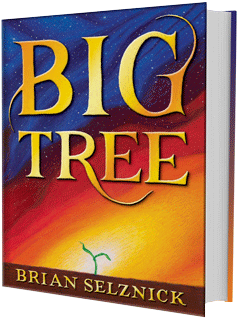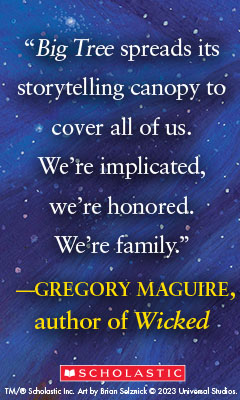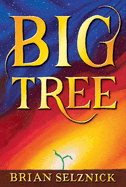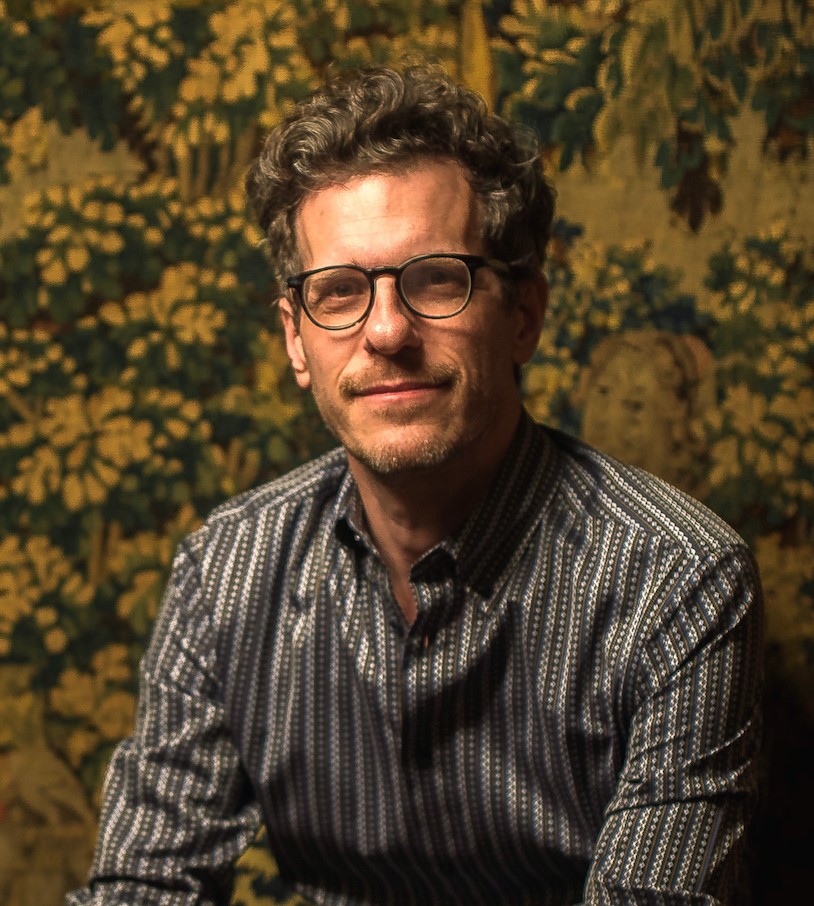Big Tree
by Brian Selznick
Two tenacious sycamore seeds bear witness to the passing of millennia in an epic struggle for survival in Brian Selznick's cinematic and hopeful Big Tree. The seeds are catapulted into an adventure of many lifetimes, a tale planted in nature but endearingly tinged with the fantastical, a saga that unfolds over more than 500 pages of Selznick's contemplative text and characteristically intricate black-and-white pencil images.
Tiny Louise cannot see past her siblings with whom she is crammed inside a sycamore seed ball. Despite her limited view, Louise's imagination runs wild and she dreams "the stars [are] calling" to her. "I think they're trying to tell me something, but they're very hard to understand," she laments to her seed-sibling Merwin. One peaceful dawn is interrupted by an urgent message for their mama from the Ambassadors, mushroom emissaries from "a vast underground system... connecting all the roots of the trees in the forest like an endless river of knowledge." A Giant is coming, they report, and a confusing signal warns the mushrooms of "Danger!" Those warnings prove real and imminent: there is a fire, and one Giant--revealed over a dozen tense pages to be a long-tailed dinosaur--begins a stampede. Mama launches her children and, before they explode into the sky, she reminds them she provided them with "roots and wings" for life on their own.
The seed siblings cling to one another's fluff during their tumultuous flight, which ends in a brief island respite (of sorts) before they tumble into an underwater fiefdom. King Seaweed, whose narcissistic dialogue reads like a comical Disney villain, traps them in a shell where they meet another network of messengers, the Scientists. Like Louise, the Scientists hear faint messages, theirs from a voice they call the Old One "that speaks of a warning" they cannot yet understand. "Louise, there is no Old One," dismisses Merwin. But a Scientist floats over to Merwin. "Maybe you are not paying attention." "Paying attention to what?" the little seed asks. "The world," the Scientists answer in unison.
At every turn, that world places the seeds in peril as they struggle to find a place to take root. Even when they finally return to land, Louise has a sense of foreboding and Merwin is myopically focused on reaching a nearby mountain. "Something bigger than we can imagine" is coming, says Louise knowingly. "The voice wants me to help...."
Louise and Merwin's adventures continue. They flee threatening cattails and free a tiny, winged insect from its cocoon, an ally they name Spot who returns later in the story to repay the favor. A decomposing leaf offers the seeds a meditative lesson on the cycle of life, and they are briefly eaten by a dinosaur with "huge yellow teeth and a vast pink tongue." When they finally reach the mountain, it proves their most dangerous encounter yet. The pair become separated and millennia pass. Time and memory blur. During this solitude, Merwin finally listens to the voice Louise had long ago perceived. Through a stretch of spare prose, expansive drawings and blank pages, the omnipotent Old One shares with Merwin a history of the cosmos and offers Merwin an understanding of what Louise had recognized long before about the power of community in the natural world. The siblings are ultimately reunited in a joyful turn of events before the story hurtles forward 66 million years to close with another sprout joining a community of nature, thanks to the helping hands of a gentle child.
Fans of Selznick's celebrated prior works such as The Invention of Hugo Cabret and Wonderstruck will be familiar with his signature approach to storytelling using an elaborate blend of prose and detailed drawings. As with many of Selznick's books with human protagonists, Big Tree is fundamentally the story of a child separated from a parent and forced to find their way alone. (Louise and Merwin's wandering just takes a few millennia longer than most.) More than half of this adventure unfolds through images, with large-scale cosmic collisions as carefully rendered as close-ups of finely etched tree bark, delicate lacewings and the comically arched brow of a befuddled carnivore. Constant shifts in perspective and proximity match pace with the seeds' turbulent journey. Selznick, through an exquisite use of negative space, conveys the loneliness of Merwin's extended dormancy (captured, aptly, in a chapter entitled "Time"), and the author perfects the art of the page turn throughout, offering readers commanding results.
This story originated with filmmaker Steven Spielberg and animation mastermind Chris Meledandri before the pandemic ground their screen project to a halt. Selznick's cinematic rendering lends intimacy to a printed tale that is at once enormous in scope yet profoundly direct in its messaging. The story is richly detailed and firmly rooted in scientifically accurate information (as explained in helpful backmatter), though Selznick takes some necessary liberties with the anthropomorphization of the seeds.
Big Tree demonstrates impressive versatility, with its genre-expansive themes and accessibility to early and visual readers with simultaneous appeal to an older audience. While potentially introducing many to harmonious phenomena like fungal systems and the Wood Wide Web, the story underscores an immediate need for us to stop, listen to nature and work together to avoid the environmental disasters awaiting us on our current path. "It's a hard world for little things," concedes the Old One, but "there's always something you can do." --Kit Ballenger








